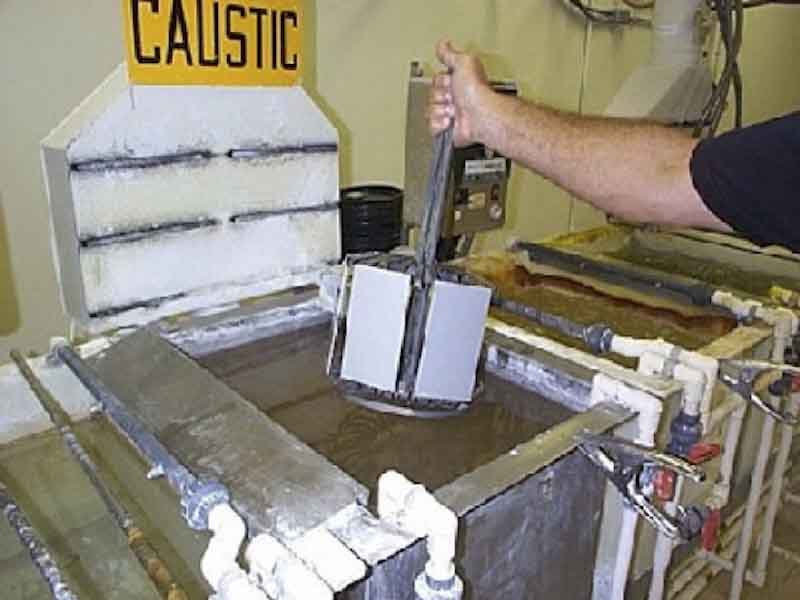Most anodizers have a caustic etch bath in their process line to use for stripping aluminum racks before re-use, activating the surface of parts before going on to be anodized and for many finishers it is used to impart a low gloss appearance to the surface.
 Mark JozefowiczJob shops often use the etch bath to “activate” the surface of the parts. In other words, to free the part of any surface film and to present pure base metal to the anodize operation. These shops will give their loads a quick one or two minute “flash” etch. Architectural and decorative anodizers who use the etch bath to produce a low gloss surface finish use treatment times ranging from eight to fifteen minutes.
Mark JozefowiczJob shops often use the etch bath to “activate” the surface of the parts. In other words, to free the part of any surface film and to present pure base metal to the anodize operation. These shops will give their loads a quick one or two minute “flash” etch. Architectural and decorative anodizers who use the etch bath to produce a low gloss surface finish use treatment times ranging from eight to fifteen minutes.
Caustic soda, another name for sodium hydroxide, is the primary chemical in an etch bath. The “free” or available caustic vigorously reacts with aluminum to produce hydrogen gas as well as heat. The physical result of this reaction is the formation of very small pits on the aluminum surface. Higher temperature and a higher caustic will speed up the reaction. To keep the etch reaction under control, the tank is often cooled, and the free caustic is kept in check. The temperature is usually kept between 120 and 150 degrees Fahrenheit.
Maintaining a Consistent Etch Finish
In a new bath, all of the caustic is available to react with aluminum, however as the bath ages only the free caustic is available. To maintain a consistent etch finish and minimize the potential for sludge formation, the free caustic must not be allowed to drop below a certain concentration.
As the bath ages, the level of aluminum increases, and the etch quality improves. A new bath with no dissolved aluminum can be overly active, and produce a grainy appearance on the part. On the other hand, when there is too much dissolved aluminum, sludge will appear, and in a worst case scenario, this sludge will begin to convert to a rock hard scale on the tank walls and heat exchanger. Sludge and scale are responsible for most of the maintenance headaches associated with an etch tank.
Anodizers who do not use etch additives must resort to regularly draining the etch bath, and then shoveling out the sludge. This is a messy, dangerous job that affects the productivity of the anodize line.
When Anodal Etch Additives are added to the bath along with caustic, over time the aluminum level will steadily climb until it reaches a point of equilibrium. That point will wander up and down, depending on the kind of work that is being run through the tank. For architectural finishers, aluminum levels of 150 grams per liter are common. For job shops, this point is more often in the range of 60-90 grams per liter. Anodal Etch Additives stabilize the dissolved aluminum and prevents unwanted sludge and scale.
Fully-Blended Etch Product Can Be Used
A new etch bath is typically made up with 30-40 grams per liter free caustic and 1-2 percent Anodal Etch Additive. Over time, as the bath ages, the free caustic is increased to 55-70 grams per liter. Whenever caustic is added to the bath, a ratio amount of Anodal Etch Additive is included. Alternatively, a fully blended etch product can be used. These products can be attractive to smaller job shops that don’t want to be bothered with multiple chemical additions. Fully blended etch products include Anodal Etch LG powder, and Anodal Etch SD-1 granules.
Improvements to etch quality can sometimes be made by adding grain refiners to the etch bath. These chemicals improve the gloss and reduce the visibility of extrusion die lines. Several Anodal Etch Additives are formulated with grain refiners already included. One such popular product is Anodal EC-2 Liq.
Second to sludge and scale, job shop anodizers are faced with the problem of rinsing viscous etch solution from their parts. Rinsing of small diameter blind holes is particularly difficult. When not adequately rinsed, an adherent aluminum oxide scale will form in these difficult to rinse areas.
Some anodizers have found that a wetting agent when added to the etch bath will act as a rinse aid. Another method that can be used to deal with this rinsing problem is to use a double-dip etch treatment. Rather than a one 2- minute etch, use two 1-minute etch treatments. Be sure to rinse after each dip. A warm water, air agitated rinse will also help remove any residue.
If all else fails, manually blowing out each hole with a pressurized air wand may be necessary. If this is done, keep in mind that airborne backwash coming into contact with another load in the process line will result in white spots on the final product.
Eliminating Etch Smut
A discussion on the caustic etch cannot be complete without mentioning etch smut. Etch smut is the residue left on the parts after they are removed from the etch bath. It is made up of the compounds found in different aluminum alloys that don’t chemically react in the etch tank. They are left behind on the aluminum surface. Etch smut varies with the alloy. In fact, an experienced anodizer can tell by looking at the etch smut, what alloy is being processed. This operator sensitivity can be a valuable tool in spotting metal related anodizing problems. A difference in etch smut between parts on a load is a sure sign of a difference in their metallurgy, that may ultimately lead to a difference in their surface finish.
The analysis of an etch bath should be conducted frequently – at least once per shift. This is because free caustic is used up as it reacts with aluminum. Its level should never be allowed to drop below a certain cut-off level – usually 50 grams per liter. The analysis is a simple acid/base titration but the end point can be hard to pinpoint. Don’t worry; it becomes easier with a little practice.
Mark Jozefowicz is Vice President of Technical Services at Reliant Aluminum. Visit http://www.reliantaluminumproducts.com



































